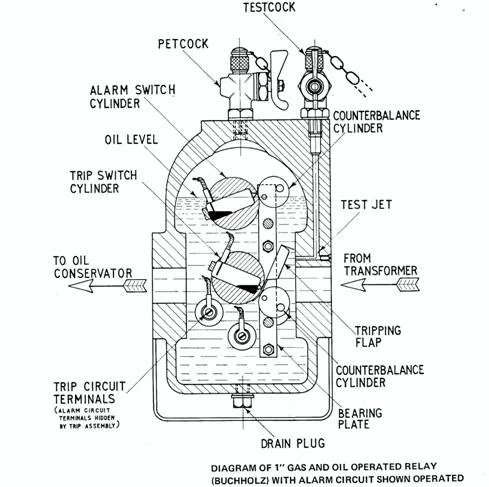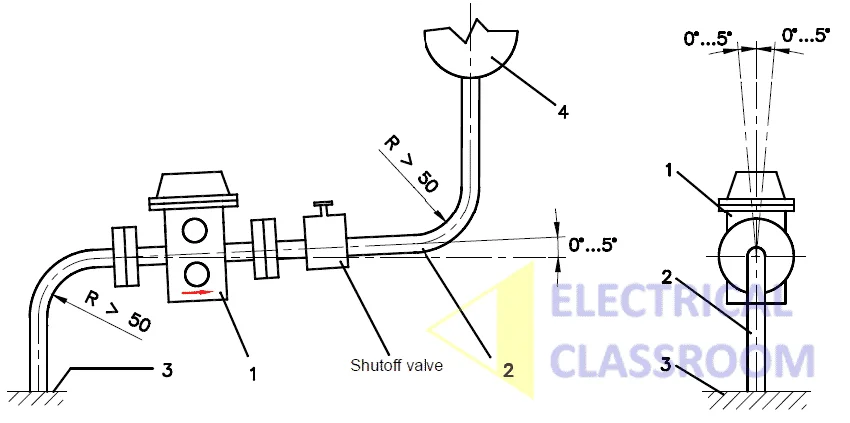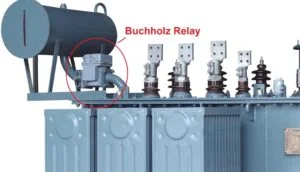A Buchholz relay in a transformer is an oil-activated relay, used to sense abnormalities such as short circuits, overheating, and oil leakages inside a transformer. It is a cylindrical object found in the pipe connecting the conservator to the main tank, in large oil-immersed transformers. It is very common in all oil-immersed transformers rated higher than 500kva.
The working principle of Buchholz relay
Faults that occur inside an
In the case of large faults, a huge

Construction and design features

The external casing and terminal box of a Buchholz relay are made up of aluminum alloy. It is a weatherproof and oil-tight design that holds inside two float switches, one at the top and the other at the bottom, for sensing oil level and flap to sense oil surge. Two reed switches/mercury switches, one for alarm and the other for circuit breaker
A gas-release cork is provided at its top to expel the accumulated gases. An electrical circuit contact test button and the terminals are enclosed in a weather-resistant cast aluminum alloy terminal box fitted at the top of the relay. A drain cork is provided at the bottom of the casing. The electrical circuitry is Modern relays that come with provision for analog and digital signal options for continuous gas accumulation and flow speed monitoring.
Why is the Buchholz relay used in the transformer?
It is used to detect the faults that occur inside the main tank of the transformer such as inter-turn faults, insulation breakdowns, short circuits, earth faults, overheating of the core, oil leakage, etc. It senses these faults and interrupts the transformer’s input supply, so that greater damages may be prevented. It also serves the purpose of fault diagnosis.
It triggers the alarm and/or trips the input supply to the transformer based on the level of oil inside it. It also responds quickly to the unusual oil flow from the transformer main tank to the oil conservator. It is a protection and monitoring equipment not only for transformers but also for oil-immersed chokes with an oil conservator.
Fault diagnosis
It is important to diagnose the reasons for the trip before reenergizing the transformer. The samples of gases trapped in the relay are collected on the occurrence of a fault. The trapped gases must be analyzed immediately. The color of the gases collected indicates the type of fault as follows:
- Whitish gas: it is caused by electric arcing in contact with paper, cotton, and silk
- Yellowish gas: it is caused by wood and cardboard
- Greyish gas: it is caused by a breakdown of the magnetic circuit
- Black gas: it is caused by free arcing in the oil
Protection features
A Buchholz relay protects the transformer from the following conditions:
- short-circuited core laminations
- short-circuit between phases/ earth
- overheating of transformer winding
- oil leakage from the main tank.
- air Inlet
- puncture of bushing insulators inside the tank
- Earth faults
In case of slight faults gas passing from the main tank to the conservator gets trapped in the relay. The oil level lowers slightly, so as the upper float. This operates the alarm contact. The same thing shall happen if free gases are present in the main tank.
In case of severe faults such as oil leakages, overheating of core/windings oil level in the relay and conservator falls continuously. Eventually, the relay, connecting pipe, and conservator are emptied and the lower float switch is operated. This activates the trip contacts and the transformer is disconnected from the supply.
In the
Mounting arrangement
A Buchholz relay is located on the pipe connecting the main tank and the conservator of the transformer. The pipe is normally tilted at an angle of 5 degrees to the horizontal in order to allow easy oil flow.

Buchholz relay – alarm and Trip circuits
The upper reed switch (attached to the upper float switch) is connected to an alarm circuit and the lower reed switch (attached to the lower float switch) is connected to the trip circuit of the circuit breaker at the incoming side of the transformer. During large faults, the lower reed switch activates the trip circuit of the circuit breaker and interrupts the power supply to the transformer, thereby avoiding large accidents.
Smart Buchholz relay
Smart Buchholz relays are equipped with sensors for sensing the oil temperature and moisture content of the transformer oil and the properties of gas accumulated in the relay during faults. These sensors send the sensed data to Programmable logic controllers or Substation automation systems. This enables the continuous monitoring of the relay from a remote location. It is also equipped with the standard features of conventional relays.
Advantages and disadvantages of Buchholz relays
They can detect faults at the early stage and is the simplest form of transformer protection. However, the drawback is that it can be used only in the oil-filled transformer.
Summary
Buchholz relay: A device that detects faults inside oil-filled transformers by sensing the level and flow of oil and gas. It is a cylindrical object located in the pipe connecting the main tank and the conservator of the transformer.
Working principle: The relay has two float switches and a flap that activates alarm or trip contacts when the oil level falls or surges due to fault conditions. The contacts are connected to external circuits that alert the operator or disconnect the power supply to the transformer.
Fault diagnosis: The relay collects gas samples from the transformer oil during faults. The color and composition of the gas indicate the type and severity of the fault. The relay also has sensors for monitoring the oil temperature and moisture content.
Advantages and limitations: The relay is a simple and effective protection and monitoring device for transformers. It can detect faults at an early stage and prevent major damage. However, it can only be used in oil-filled transformers.


Explained beautifully
BUCHHOLZ RELAY GATE VALVE ,
DN:80 ,
L:180MM , H1:300MM , D:200MM , K:160MM ,
Number OF Holes:8 ,
BODY: BRONZE ,
SUITABLE FOR TRANSFORMER OIL ,
WORKING TEMPERATURES: -25 TO 115 C PACKING MADE OF GRAPHITE AND
ASBESTOS FREE MATERIAL
SEALING RING MADE OF NBR ,
PAINT: OIL RESISTANT ,
FOR ARC FURNACE TRANSFORMER
Qty: 1 stock
RELAY BUCHHOLZ FOR THE MSEF TRANSFORMER CONTACT OPERATED BY UPPER FLOAT SWITCHES FOR
GAS ACCUMULATIO N AND LOW OIL, SWITCHES VALUES: 200cm3 INDICATED VALUES OIL FLOW: < C/L PIPE 1.0m/s.
TAMINI TRASFORM ATORI MELEGNANO (MI) – ITALY, IEC: 60076, ARC FURNACE THREE PHASE TRANSFORMER, N DEGREES
65898 – FOR INDOOR INSTALLATION TYPE/MODEL: RR DN 80 _ SCH 4 / 306 MAKE: ET